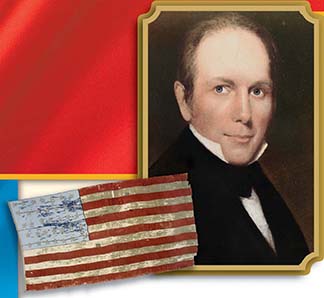SECTION 3: An Era of Nationalism

▲ Old Glory flag, 1820s
◄ Henry Clay
WITNESS HISTORY  AUDIO
AUDIO
In the Spirit of Nationalism
Nationalistic feelings ran high following the War of 1812. Many Americans sought to strengthen their nation. Among them was Henry Clay, Speaker of the House, who proposed a national economic plan called the American System. He sought to protect American farmers and manufacturers from foreign competition:
“This transformation of the condition of the country from gloom and distress to brightness and prosperity, has been mainly the work of American legislation, fostering American industry, instead of allowing it to be controlled by foreign legislation, cherishing foreign industry.”
—Henry Clay, “The American System,” speech in the Senate, 1832
Objectives
- Analyze the causes and effects of nationalism on domestic policy during the years following the War of 1812.
- Describe the impact of nationalism on the nation’s foreign policy.
- Summarize the struggle over the issue of slavery as the nation grew.
Terms and People
- nationalism
- Henry Clay
- American System
- John Quincy Adams
- Adams-Onís Treaty
- Monroe Doctrine
- Missouri Compromise
NoteTaking
Reading Skill: Understand Effects Fill in a concept web to identify the effects of nationalism on the nation’s domestic and foreign policies.

Why It Matters Nationalism was a dominant political force in the years following the War of 1812. It affected economic and foreign policy and was supported by Supreme Court rulings. The building of the nation’s pride and identity was an important development that helped the country grow. Section Focus Question: How did domestic and foreign policies reflect the nationalism of the times?
Nationalism Shapes Domestic Policies
In 1817, a newspaper in Boston described politics as entering an “era of good feelings.” The Democratic Republican Party operated almost without opposition. In the election of 1820, James Monroe won reelection as President by receiving almost all of the electoral votes cast. (John Quincy Adams received one electoral vote.) A spirit of nationalism—a glorification of the nation—swept the country.
Nationalist Economic Policies
In the last section, you read about some of the economic policies that promoted the growth of industry. A leading example was the Tariff of 1816. By embracing a protective tariff, many Democratic Republicans betrayed their former principles. Once they had opposed federal power, supported agriculture, and favored trade unburdened by tariffs. Now they used federal power to help industrialists and their workers.
Henry Clay was one of the leading




